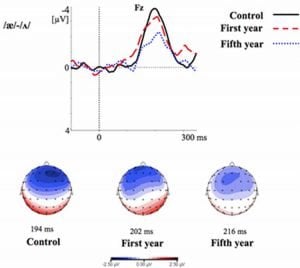A recent study shows that assimilation of L2 vowels to L1 phonemes governs language learning in adulthood; researchers urge development of novel methods of second language teaching.
The behavioral and neural evidence of the study was found by researchers at Aalto University in Finland and at the University of Salento in Italy.The study was the first one to identify the neural mechanisms underlying the learning of L2 sounds (second language) in adulthood. Overall, this and earlier studies support the hypothesis that students in a foreign language classroom should particularly benefit from learning environments where they receive a focused amount of high-quality input from L2 native teachers, use pervasively the L2 to achieve functional and communicative goals, and receive intensive training (including the use of multi-medial systems) in the perception and production of L2 sounds in order to reactivate neuroplasticity of auditory cortex.
Learning in adulthood the sounds of a second language L2 means assimilating them to the phonemes of the native language L1.

In the study, two samples of Italian students, attending first year and fifth year classes of an English Language curriculum were invited to the behavioral and electroencephalography (EEG) lab. Dr. Brattico, senior author of the study from Aalto University, explains: “The discrimination skills were measured by crossing two methodologies: on one hand, perception tests in which the students listened to couples of English sounds that I synthesized and had to judge how similar or different they were, and on the other hand, EEG recordings with 64 electrode cap, while the students were presented with the same pairs of sounds and watched a silenced movie.”
The EEG recordings were used to extract the auditory event-related potential, namely the succession of neural events necessary to the processing and representation of sound, originating from the auditory cortex.
“When we hear linguistic sounds that are part of our native tongue, in a few milliseconds the brain is able to decipher the acoustic signal, extract the peculiar characteristics of each sound and produce a mental representation of it: thus we are able to discern one sound from another and assemble first the syllables, then the words and so on”, adds the first author, Professor Grimaldi, University of Salento.
“We compared the neural responses of the auditory cortex of the two groups of university students with one another and with a control group with a low level of education (third year of junior secondary school)”, explains Grimaldi. “We started with this hypothesis: if during the academic studies the students had developed new perceptual abilities we would have found different neural responses for the three groups”. The results did not confirm the hypothesis, but instead showed that neutrally, the L2 sounds were assimilated to L1 phonemes in all the groups.
Grimaldi adds: “Let us consider, for example, what happens when we watch a movie or listen to a song in a language that we do not know: we are able to perceive acoustic differences, but we cannot `extract´ the words from the acoustic stream and accede to their meaning. This is what happened for our groups of students”. Previous behavioral studies that observed L2 learners who had different native languages in an educational context (German, Finnish, Japanese, Turkish and other English learning students) never produced results favorable for the teachers. “This study specifies confirms and extends such results, proving by means of neurophysiological data that the quantity and quality of the stimuli received by university students are not enough to form long-term traces of L2 sounds in the auditory cortex”, confirms Brattico.
Source Dr. Elvira Brattico – Aalto University
Contact: Aalto University press release
Image Source: The image is adapted from the Aalto University press release
Original Research Full open access research for “Assimilation of L2 vowels to L1 phonemes governs L2 learning in adulthood: a behavioral and ERP study” by Mirko Grimaldi, Bianca Sisinni, Barbara Gili Fivela, Sara Invitto, Donatella Resta, Paavo Alku and Elvira Brattico in Frontiers in Human Neuroscience. Published online May 13 2014 doi:10.3389/fnhum.2014.00279
Assimilation of L2 vowels to L1 phonemes governs L2 learning in adulthood: a behavioral and ERP study
According to the Perceptual Assimilation Model (PAM), articulatory similarity/dissimilarity between sounds of the second language (L2) and the native language (L1) governs L2 learnability in adulthood and predicts L2 sound perception by naïve listeners. We performed behavioral and neurophysiological experiments on two groups of university students at the first and fifth years of the English language curriculum and on a group of naïve listeners. Categorization and discrimination tests, as well as the mismatch negativity (MMN) brain response to L2 sound changes, showed that the discriminatory capabilities of the students did not significantly differ from those of the naïve subjects. In line with the PAM model, we extend the findings of previous behavioral studies showing that, at the neural level, classroom instruction in adulthood relies on assimilation of L2 vowels to L1 phoneme categories and does not trigger improvement in L2 phonetic discrimination. Implications for L2 classroom teaching practices are discussed.
“Assimilation of L2 vowels to L1 phonemes governs L2 learning in adulthood: a behavioral and ERP study” by Mirko Grimaldi, Bianca Sisinni, Barbara Gili Fivela, Sara Invitto, Donatella Resta, Paavo Alku and Elvira Brattico in Frontiers in Human Neuroscience, May 13 2014 doi:10.3389/fnhum.2014.00279







